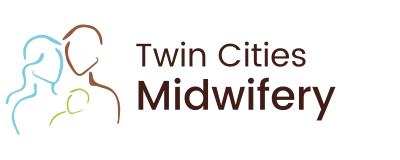10 Sep The Lowdown on Out-of-Hospital (OOH) Birth
by Kate Saumweber Hogan, CPM, LM
(I had the honor of writing this post for the Childbirth Collective’s blog, but wanted to repost it here since it addresses common questions that I hear all the time about home birth. I also thought it would be a great 100th post for the TCM blog!)
What is OOH Birth?
Out-of-hospital (OOH) birth refers to births occurring outside of a hospital, such as at a home or a free-standing birth center that is not connected to a hospital.
Planned OOH births can be in a house, townhouse, apartment, trailer, hotel, friend’s house, birth center, or even a back yard! Most homebirth midwives are pretty flexible with space needs, and can make almost any “home” work. Ideally, there should be running water, electricity, and a phone (or cell phone service), but even those can be negotiated!
What do all of those letters mean after midwives names?
There are two general kinds of midwives in our country. There are nurse midwives who are primarily trained in a hospital setting and most often attend births in the hospital; they are called Certified Nurse Midwives (CNMs). Some CNMs gain additional experience to offer OOH care as well.
The second type are direct entry midwives; these midwives are primarily trained in the home birth or OOH setting and provide care in this setting. Some direct entry midwives earn the national credential of Certified Professional Midwife (CPM). In Minnesota, CPMs also have the option of becoming licensed by the state, which also gives them the title of Licensed Midwife (LM). It is a good idea to ask your midwife what her credentials are, especially in Minnesota where there are so many possible combinations!
It is safe to birth at home or at a birth center outside of a hospital?
Midwives are experts in normal. So for normal, low-risk, healthy moms and babies, YES, research shows that with a trained care provider, it is as safe or safer to be OOH than being in a hospital setting. However, OOH birth isn’t for everyone. Your midwife will help determine if you are a good candidate for OOH birth, and will continue to monitor you and your baby during pregnancy, labor, and delivery to ensure that it is still safe to be at home.
If you would like to read the research available regarding home birth, a thorough review is available through Midwives Alliance of North America.
The question is often, “is homebirth safe,” but rarely, “is hospital birth safe.” This article looks at the other side of the coin.
What equipment do OOH midwives bring?
Each midwife will have a little variation in her birth bags, but in general, most midwives are certified in neonatal resuscitation and CPR, and will have equipment pertaining to those certifications. She will have medical supplies such as oxygen, suction for baby, medications for hemorrhage, a fetoscope and doppler to monitor baby’s heartbeat, a baby scale, and equipment to check mom’s vitals (blood pressure cuff, stethoscope, thermometer, a watch).
Some midwives carry IV equipment, suture and lidocaine for perineal tears, a pulse oximeter, a variety of herbal and homeopath remedies, and a birth stool. Some midwives also rent birth tubs and have additional equipment relating to the tub. Be sure to ask your midwife what you can expect her to bring to your birth.
Most midwives have families purchase a birth kit, which will have all of the disposable things that are needed for the birth, such as underpads, gloves, gauze, and a peri bottle. Families will also be asked to gather a list of supplies to use at the birth, such as towels, baby blankets, and extra pillows.
Is homebirth messy?
This question comes up a lot! Surprisingly, birth is not at all like it is portrayed in the media and it really isn’t very messy. Your midwife uses supplies from your birth kit to help protect your bed and floor. She will start the laundry and clean up any sign of your birth before she leaves your home so your visitors won’t even know where the birth happened! There isn’t even very much trash, often barely enough to fill a kitchen sized garbage bag. You may have a second bag of trash if you are using a birth tub with a large plastic liner.
What about labs, ultrasound, and newborn care options?
When you interview potential midwives, it is good to ask if they offer routine labs, ultrasounds, and newborn care options (vitamin K, erythromycin, newborn metabolic screening, hearing screening, CCHD screening). Some midwives offer them as part of routine care, and others would refer you to your primary clinic for these services. Informed consent and shared decision making is at the heart of midwifery care. Prenatal visits will be an opportunity to discuss the pros, cons, and alternatives, and make a decision together about what is the best choice for you and your family. If you’d like to decline testing or newborn options, you can! It is your choice and it shouldn’t be a fight! But it can be nice to know what options will be available to you, since there may be some that you want for yourself or your baby.
If the midwife you choose doesn’t offer the newborn screening options (metabolic screening, hearing screening, and CCHD) most midwives who offer these options are willing to see babies outside of their practice for these screenings. You can find providers who offer these services here: http://minnesotamidwives.org/MCCPM/Newborn_Hearing_Screening.html
Does insurance cover it?
Sometimes! There isn’t an easy yes or no answer, since it is really plan dependent. Most OOH midwives are out-of-network and will be covered based on your out-of-network benefit levels. Many of the birth centers are in-network and are covered at that level. Some midwives bill insurance, and others don’t. Midwives who offer insurance billing usually can do a benefits check to give you a better idea of what you can expect to be covered. If you have an HSA or flex spending plan, those funds can go towards paying for your midwifery care. The vast majority of the time, even paying 100% out-of-pocket for your home birth is less expensive than the out-of-pocket costs for a hospital birth after insurance processes the claim. The Childbirth Connection is a good resource for comparing costs by birth place from a national level.
Can I have a doula and a midwife?
Yes! Many out-of-hospital midwives encourage each woman to consider having a doula at her birth. Doulas provide continuous emotional, physical, and informational support before, during, and after birth. Many midwives offer this kind of physical and emotional support as well. However, unlike midwives, doulas don’t provide any medical care. Doulas are great at offering comfort measures and supporting both the laboring woman and her partner from early labor until after baby is born. Be sure to check out the Childbirth Collective for free parent topic nights and ample opportunities to meet with and interview doulas.
How do I find a midwife who works in a home birth or birth center setting?
Check out the midwife listings on the Childbirth Collective, view members of the Minnesota Council of Certified Professional Midwives, and check out this comprehensive list of midwives from Minnesota Families for Midwifery. Most practices offer a free consultation to see if the midwife and family are a good fit, that is a great opportunity to ask any additional questions you may have about out-of-hospital midwifery and birth!
Kate Saumweber Hogan is a certified professional midwife and licensed midwife, serving Minnesota and Wisconsin. She is the owner of Twin Cities Midwifery where she provides prenatal, home birth, newborn, and postpartum care. She sees families at clinic spaces in Minneapolis and White Bear Lake, and lives in south Minneapolis with her husband and nursing daughter, born at home in the water in December 2012.










Sorry, the comment form is closed at this time.